Maximum contact 26 February 1998, Eclipse of the Sun
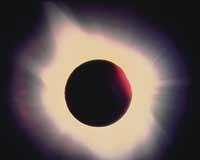
What is a solar eclipse?
The total eclipse of the Sun is an astronomical phenomenon produced by a natural coincidence. Seen from Earth to heaven, the Moon and the Sun appear to be the same size. The Moon has a diameter of 3,475 kilometers and is 400 times smaller than the Sun (1,392,000 kilometers in diameter), which means that the Sun is 400 times farther. If the Moon is at the necessary distance from the Earth, its apparent size can completely cover the Sun causing a total eclipse of the Sun.
The inclination of the orbit of the Moon to that of the Earth (ecliptic) is about 5 degrees, so normally the shadow of the Moon passes above or below the Earth, so there is no total eclipse of the Sun in each New Moon 1. The phenomenon occurs when our satellite is located in one of the two intersections of both planes (one of the nodes).

While the eclipse lasts, the cone shaped shadow of our satellite reaches the Earth. As a result of the rotation of the Earth and the translation of the Moon, the shadow causes a sweep, explaining the places where the phenomenon can be seen. The shade is formed by the umbra and the penumbra that surrounds it. The umbra, when moving, creates the so-called total eclipse path (Figure 1), a dark corridor that reaches a maximum distance of 273 kilometers. In it the phenomenon is total. The total eclipse is half the dark corridor. On both sides of the mist, the gloom extends to thousands of kilometers, causing a partial eclipse.
The total eclipse is short, it can last up to seven and a half minutes, and although there is an average of 18 months, for a point of the Earth, for example a city, can pass centuries. The information that can be extracted from the few minutes that the total eclipse lasts is something usual, since the layers of the solar atmosphere that normally remain hidden by the action of the photosphere are uncovered. In addition, the total eclipse of the Sun offers the perfect opportunity to carry out different investigations in different fields, from relativistic physics to the areas of interaction of the Earth.
General state of the eclipse

The eclipse of February 26, 1998 was number 51 in the 130 series of Saros 2, with 73 solar eclipses in 1,334 years. Series 130 began with a partial eclipse in the South Pole of August 20, 1096 and will end with another partial eclipse that will occur at the end of the North Pole on November 11, 2430.
On February 26, 1998, the umbra of the Moon began its encounter with the earth at a point in the Pacific, at 144th West and 2nd South of the Greenwich meridian. Then he began his supersonic journey to the East covering part of the Galapagos (islands Pinta and Marchena, and north of the island of Isabela). Before reaching the coast of Panama and Colombia it had the maximum duration of its total eclipse: 4 minutes 8 seconds. He then entered the south of Panama and, at the same time that he showed a total eclipse on Colombian lands, crossed the Venezuelan border in the Gulf of Venezuela, on the impressive peninsula of Paraguaná and entered his first city, Punto Fixed.
The largest oil refinery in the world (PDVSA) is in this city. After its departure from the peninsula, the umbra did not return to contact the continent, covering only some islands: Aruba (now sovereign, formerly dominated by the Dutch), Gurazao, north of Bonaire and some part of the Antilles (Ancient, Montserrat), including the French Guadalupe. The long route of the Umbra ended after crossing the Atlantic, 300 kilometers northwest of the Canary Islands. In less than three and a half hours he traveled 14,000 kilometers.

Penumbra, to the north, encompassed the sections of the Pacific, the Caribbean, Central America, Mexico, part of the United States, Eastern Canada and much of the North Atlantic. To the south, in addition to the Pacific, it covered the upper part of the South American cone, the South Atlantic, and the lands of western Africa.
In search of the black sun
The public and researchers met in three areas: In the area of Maracaibo, the lunar umbra completely covered the peninsula of Paraguaná and the island of Aruba. In the latter, as half of the dark corridor left off the island, cruises were organized. Once the eclipse is finished and taking into account the meteorology, the ease of approximation and the duration of the total eclipse, it is considered that the best conditions for the observation of this eclipse were given in the peninsula of Paraguaná, with the sky perfectly clean, with a total eclipse of 3 minutes and 45 seconds (Figure 3).
The Paraguana peninsula reminds the human skull. It is 50 kilometers wide in the E-West direction and 60 in the North-South direction. The largest peninsula in Venezuela has a desert climate with a unique ecosystem. Although the annual rainfall rate is low, this land of the state of Falcón was an important agricultural producer before oil exploitation. In addition, statistically, February is the driest month of the year.
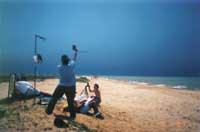
According to the data provided by its official agencies, more than a million people arrived in the peninsula, coming from the area and abroad, astronomers, researchers, specialized observers and tourists, known as “temporadistas”. On the occasion of the arrival of the eclipse, almost coinciding with the celebrations of the carnival, special measures were taken: on the one hand, to give good information about the phenomenon to the population, to take security measures when looking at the eclipse and being able to reach the center of the corridor of darkness, placing in all the routes the necessary signaling with the slogan “path of the eclipse”.
On the other hand, a suitable place was enabled for the observation of own and external researchers and specialists. 10,000 people and 25 ambulances formed the work team. Delivery and delivery of 100,000 glasses through different entities. The day of the eclipse, Thursday 26 February, was declared festive by the Government of Falcón.
The forecasts were spectacular for the day of the eclipse, since in all different media the phenomenon was announced as something rare and terrible (in Venezuela the next total eclipse of the Sun will occur on September 23, 2071). The show was broadcast live by Venevisión, the most important television network in Venezuela.
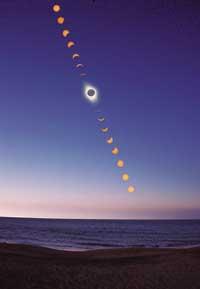
Venevision was installed in the place called El Pico, the only space reserved for journalists and experts in army control. The beach of El Pico is very peculiar, a small and sharp cape in the shape of a parrot peak, which tightens about 2 kilometers towards the Gulf of Venezuela. The Pico was located 8 kilometers south of the center of the dark corridor, where the total eclipse duration was expected to be 3 minutes and 43 seconds.
Day “E” total experience
On February 26 we set ourselves in the place of the Pico we had preselected. The observation program was very wide, with photographs of great power with motorized camera, panoramic photographs and all-sky. Similarly, we should try to capture in the photos the shadow bands that are generated around the total eclipse. We wanted to make measurements of wind, temperature and luminosity in the field of the meteorological environment, as well as its influence on the fauna.
As the partial eclipse began from noon, he put all the tooling on us and gave us time to prepare it properly. The partial phase began at 12 and 36 minutes, with the sun at 69 ° height and the absence of fog in the sky, despite winds of average intensity.
The first three quarters of an hour normally passed, as if it were a conventional partial eclipse. From that moment, when 50% of the Sun was covered, and almost suddenly, a decrease in the luminosity of the environment began to be noticed (something that the photometer indicated almost half an hour before). The Sun then did not “burn” as before, even though the temperature dropped by one degree (and we were at 31 degrees). The eclipse effect, the lunar yellowish, was evident if observed with a simple sunscreen. The facts accelerated. The luminosity decreased significantly and the fauna, especially the pelicans, which existed around, began to fly nervously.
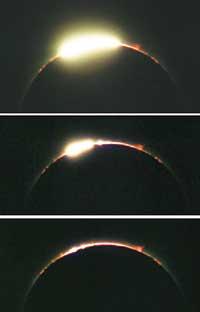
At 13:42, at half an hour of the total eclipse and with 70% of the covered Sun, it was observed that the sea was darkening, seeing the most marked horizon. A gust of wind dropped a tripod and broke the trigger of a camera with the interbalometer, which had to be used by hand from that moment on.
Another quarter of an hour was 13:56 and 85% of the Sun was covered. There were 12 minutes left for the entire eclipse; the highest Sun wore the tropical environment with a strange light. Not in the tropics, it seemed that we were in the winter afternoon. From the beginning of the eclipse the wind force in the same direction was softened, but it was cooler, almost cold.
The clock indicated the time 14:05, missing three minutes to begin the total eclipse. 95% of the Sun was covered. Marine birds flying non-stop disappeared. Everything began to darken spectacularly as if it were the end of the world. In the West horizon, far away, in the sea, the first traces of an immense blue cloud were appreciated, increasing. It was a lunar umbra at 2,500 kilometers per hour. The Sun was nothing more than a fine arc of light that was shrinking at the moment.
The blackout took place in the last minute, along with the joyous cries of thousands of people who heard far off the coast (figure 4). In the Sun there was an explosion of light, a diamond ring that went off giving rise to a black hole created in the sky. This album was surrounded by a perlado and structured luminous halo, extending towards the east-west direction. It was a solar crown, beautiful and magical, as in all the eclipses of the Sun, this time represented the minimum position of the Sun.

Two other bright points next to the Sun, Mercury and Jupiter, while Venus, which could be seen before the total eclipse, appeared further away. Everything had a form of darkening, although the quality of light, tone, was indescribable; it was a rare, different light. At some times the West horizon began to illuminate, almost by chance, until another diamond ring announced the end of the total eclipse.
Minutes after the total eclipse we saw the shadow bands. They appeared as dark and clear lines alternately of very low contrast. They were almost invisible, fast movements, undulating and aimless. I think they could have an approximate width of two centimeters.
Little by little the environment became an eternal aspect, while we were privileged as witnesses of a routine event (figure 5). For most of those attending the show, it was the first and last time of his life.
Preliminary Results Preliminary Results
Sun Eclipsed
The pearls of Baily were seen well, since by the configuration of the Moon profile they were favorable in this eclipse. It occurs a few seconds before and after the total eclipse, when the photospheric light is dispersed by small orographic depressions of the lunar edge. In the photos (figure 6) you can see the formation process of these first phases of the total eclipse.
Solar bumps are one of the most beautiful phenomena of the 3 eclipses. They appear on the edge of the sun as if they were burning red clouds, formed by mists of matter at lower temperature and density than the environment. In this eclipse were many, but of small size. One was highlighted, which is observed in Figure 7, which took place at the beginning of the total eclipse, in the form of an eruption, with a fine end and a height of 56,000 kilometers, that is, four times the diameter of the Earth.
The crown was the one that people expected most during the eclipse, since it can not be seen until the total eclipse, since it is a million times clearer and the photosphere keeps it locked (Figure 8).
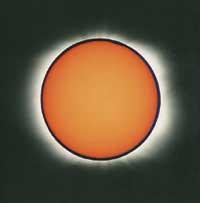
For a long time it was thought that the crown presented some unknown chemical element, baptized as coronium. In 1940 it was observed that coronium was due to current metals, at very low pressure and at high levels of ionization 4. The average crown temperature is 1,000,000 degrees. In the eclipse of February 26, a minimal type of prolonged sun appears in the E-West axis.
Today our star is 5 in the eleven year of the ascending initiative phase that will reach its peak in 2001. At a glance the crown was not very luminous. It was observed above all the circular halo that surrounded the eclipsed disc and two branches that opened towards the west and a large corrent that extended towards the east. They would have a size of six solar radios, about 4 million kilometers. You could also see some polar feathers, such as beams of light matter driven by the magnetic field of the Sun (Figure 9).
Environment Environment

The darkening of the environment was spectacular, to the point that all observers remained open. 25 minutes before the beginning of the total eclipse
(13:42), we all realized the fall of light, increasingly fast. The last 10 minutes before the second contact were the most dramatic. In fact, if until then the luminosity had decreased up to 10 times, from then on it had been reduced up to 2,000 times and would have faded. The lowest photometric measurement (4.4 lx) was taken at 14:09:56 at the center of the phenomenon. That is, if compared to the beginning of the eclipse (12:36 / 96,000 lx), the luminosity was 20,000 times lower. All this can be observed in the following graph (since the differences in value are high, it shows the luminosity logarithmic form) (Figure 10).
It was observed both when approaching the lunar umbra and when moving away. During the entire eclipse, a 360° panoramic view could be adopted in horizontal (120° in vertical), showing the aspect of the observation area towards the end of the total eclipse. In it stands the umbra, with a width of 146 kilometers, that moves towards the East occupying much of the horizon; the effect of the false dawn on the West horizon, illuminated by the sun, about 35 kilometers; and finally the Sun eclipsed with Venus on the Southeast horizon (Figure 11).
Atmospheric changes
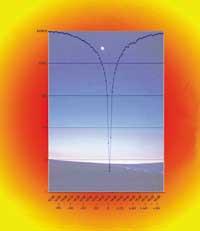
They were mainly at temperature and wind. The temperature followed the same path as photometry, decreasing as the total eclipse appeared faster, but much smoother. The temperature moved between the 28 °C of the total eclipse and the 32,5 °C that were at the beginning and at the end of the eclipse, that is, 4.5 °C less, as well as the decrease of 5 °C of the newspapers the next day.
The east direction of the wind did not vary, although in the second phase of the bias it moved towards the southeast. The intensity was also very high, on the 6th scale of Beaugres, after 20 minutes before the total eclipse and return slowly to the first.
Changes in the fauna
In addition to what is indicated for marine birds, the Eclipse Observation Commission established another type of species: goats, chickens, roosters, a dog and a donkey, all of them near the place reserved for Venevisión. All had some reaction in the phenomenon, but the most spectacular was that of the birds, who gathered as if it were night while the rooster was singing. The goats walked without a fixed course.
Eclipse schedule at El Pico (Latitude 11º 51´ N, Longitude 70º 18´ W):
First contact: 12:36:54 Second contact: 14:08:06 Third contact: 14:11:50 Fourth contact: 15:34:52
Half of the eclipse: 14:09:58 Duration of the total eclipse: 3’ 43”
(Local time, add 4 hours to get the Universal Time).
Eclipse on the internet. Project “Eclipse 98” 6

The eclipse was given live via the Internet. In that project I was one of the two Europeans. In the whole shade band, a network of observers was installed, equipped with a camcorder and a transmission system, so that the combination of all of them would virtually increase the duration of the total eclipse by half an hour. The images were sent to a control address and from there to some mirror directions for their dispersion.
However, the day of the eclipse the access was slow because many people from all over the world wanted to see the phenomenon live. In addition, the breakdown of a major transmission network in Missouri led to greater traffic moderation. As the project director “Eclipse 98”, Philip Staiger told me, “the most important problem of the project has been its success,” quoting the crowd that connected to see the transmission.
After the experience of the project team “Eclipse 98” in this eclipse, it will prepare a new transmission for the entire European solar eclipse of 11 August 1999.





